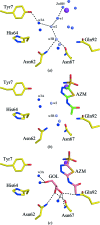Effects of cryoprotectants on the structure and thermostability of the human carbonic anhydrase II-acetazolamide complex
- PMID: 23633596
- PMCID: PMC3640473
- DOI: 10.1107/S0907444913002771
Effects of cryoprotectants on the structure and thermostability of the human carbonic anhydrase II-acetazolamide complex
Abstract
Protein X-ray crystallography has seen a progressive shift from data collection at cool/room temperature (277-298 K) to data collection at cryotemperature (100 K) because of its ease of crystal preparation and the lessening of the detrimental effects of radiation-induced crystal damage, with 20-25%(v/v) glycerol (GOL) being the preferred choice of cryoprotectant. Here, a case study of the effects of cryoprotectants on the kinetics of carbonic anhydrase II (CA II) and its inhibition by the clinically used inhibitor acetazolamide (AZM) is presented. Comparative studies of crystal structure, kinetics, inhibition and thermostability were performed on CA II and its complex with AZM in the presence of either GOL or sucrose. These results suggest that even though the cryoprotectant GOL was previously shown to be directly bound in the active site and to interact with AZM, it affects neither the thermostability of CA II nor the binding of AZM in the crystal structure or in solution. However, addition of GOL does affect the kinetics of CA II, presumably as it displaces the water proton-transfer network in the active site.
Keywords: acetazolamide; carbonic anhydrase; cryoprotectants; glycerol; sucrose.
Figures


Similar articles
-
High-resolution structure of human carbonic anhydrase II complexed with acetazolamide reveals insights into inhibitor drug design.Acta Crystallogr Sect F Struct Biol Cryst Commun. 2009 Oct 1;65(Pt 10):992-5. doi: 10.1107/S1744309109036665. Epub 2009 Sep 25. Acta Crystallogr Sect F Struct Biol Cryst Commun. 2009. PMID: 19851004 Free PMC article.
-
Effect of incorporating a thiophene tail in the scaffold of acetazolamide on the inhibition of human carbonic anhydrase isoforms I, II, IX and XII.Bioorg Med Chem Lett. 2013 Oct 15;23(20):5646-9. doi: 10.1016/j.bmcl.2013.08.019. Epub 2013 Aug 13. Bioorg Med Chem Lett. 2013. PMID: 23993330
-
Crystal structure and kinetic studies of a tetrameric type II β-carbonic anhydrase from the pathogenic bacterium Vibrio cholerae.Acta Crystallogr D Biol Crystallogr. 2015 Dec 1;71(Pt 12):2449-56. doi: 10.1107/S1399004715018635. Epub 2015 Nov 26. Acta Crystallogr D Biol Crystallogr. 2015. PMID: 26627652
-
Thermodynamic, kinetic, and structural parameterization of human carbonic anhydrase interactions toward enhanced inhibitor design.Q Rev Biophys. 2018 Jan;51:e10. doi: 10.1017/S0033583518000082. Q Rev Biophys. 2018. PMID: 30912486 Review.
-
Acetazolamide and human carbonic anhydrases: retrospect, review and discussion of an intimate relationship.J Enzyme Inhib Med Chem. 2024 Dec;39(1):2291336. doi: 10.1080/14756366.2023.2291336. Epub 2023 Dec 11. J Enzyme Inhib Med Chem. 2024. PMID: 38078375 Free PMC article. Review.
Cited by
-
Carbonic anhydrases and their biotechnological applications.Biomolecules. 2013 Aug 19;3(3):553-62. doi: 10.3390/biom3030553. Biomolecules. 2013. PMID: 24970180 Free PMC article.
-
Hidden targets in dermatology: In vitro and In silico inhibitory effects of common 23 dermatologic drugs on human carbonic anhydrase isoenzymes I and II.J Enzyme Inhib Med Chem. 2025 Dec;40(1):2540935. doi: 10.1080/14756366.2025.2540935. Epub 2025 Aug 5. J Enzyme Inhib Med Chem. 2025. PMID: 40762397 Free PMC article.
-
Novel benzenesulfonamides containing a dual triazole moiety with selective carbonic anhydrase inhibition and anticancer activity.RSC Med Chem. 2024 Oct 4;16(1):324-45. doi: 10.1039/d4md00617h. Online ahead of print. RSC Med Chem. 2024. PMID: 39493223 Free PMC article.
-
Structural, catalytic and stabilizing consequences of aromatic cluster variants in human carbonic anhydrase II.Arch Biochem Biophys. 2013 Nov 1;539(1):31-7. doi: 10.1016/j.abb.2013.09.001. Epub 2013 Sep 10. Arch Biochem Biophys. 2013. PMID: 24036123 Free PMC article.
-
Structural insight into activity enhancement and inhibition of H64A carbonic anhydrase II by imidazoles.IUCrJ. 2014 Feb 28;1(Pt 2):129-35. doi: 10.1107/S2052252514004096. eCollection 2014 Mar 1. IUCrJ. 2014. PMID: 25075329 Free PMC article.
References
MeSH terms
Substances
Grants and funding
LinkOut - more resources
Full Text Sources
Other Literature Sources

